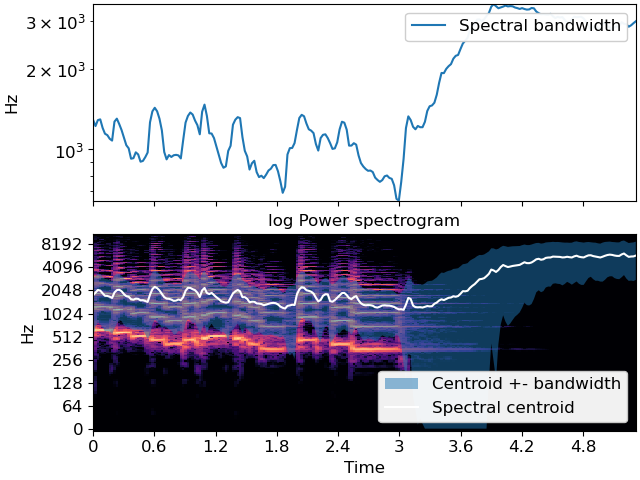Caution
You're reading an old version of this documentation. If you want up-to-date information, please have a look at 0.10.2.
librosa.feature.spectral_bandwidth
- librosa.feature.spectral_bandwidth(*, y=None, sr=22050, S=None, n_fft=2048, hop_length=512, win_length=None, window='hann', center=True, pad_mode='constant', freq=None, centroid=None, norm=True, p=2)[source]
Compute p’th-order spectral bandwidth.
The spectral bandwidth [1] at frame
tis computed by:(sum_k S[k, t] * (freq[k, t] - centroid[t])**p)**(1/p)
- Parameters:
- ynp.ndarray [shape=(…, n)] or None
audio time series. Multi-channel is supported.
- srnumber > 0 [scalar]
audio sampling rate of
y- Snp.ndarray [shape=(…, d, t)] or None
(optional) spectrogram magnitude
- n_fftint > 0 [scalar]
FFT window size
- hop_lengthint > 0 [scalar]
hop length for STFT. See
librosa.stftfor details.- win_lengthint <= n_fft [scalar]
Each frame of audio is windowed by window(). The window will be of length
win_lengthand then padded with zeros to matchn_fft. If unspecified, defaults towin_length = n_fft.- windowstring, tuple, number, function, or np.ndarray [shape=(n_fft,)]
a window specification (string, tuple, or number); see
scipy.signal.get_windowa window function, such as
scipy.signal.windows.hanna vector or array of length
n_fft
- centerboolean
If True, the signal
yis padded so that frametis centered aty[t * hop_length].If
False, then frametbegins aty[t * hop_length]
- pad_modestring
If
center=True, the padding mode to use at the edges of the signal. By default, STFT uses zero padding.- freqNone or np.ndarray [shape=(d,) or shape=(…, d, t)]
Center frequencies for spectrogram bins. If None, then FFT bin center frequencies are used. Otherwise, it can be a single array of
dcenter frequencies, or a matrix of center frequencies as constructed bylibrosa.reassigned_spectrogram- centroidNone or np.ndarray [shape=(…, 1, t)]
pre-computed centroid frequencies
- normbool
Normalize per-frame spectral energy (sum to one)
- pfloat > 0
Power to raise deviation from spectral centroid.
- Returns:
- bandwidthnp.ndarray [shape=(…, 1, t)]
frequency bandwidth for each frame
Examples
From time-series input
>>> y, sr = librosa.load(librosa.ex('trumpet')) >>> spec_bw = librosa.feature.spectral_bandwidth(y=y, sr=sr) >>> spec_bw array([[1273.836, 1228.873, ..., 2952.357, 3013.68 ]])
From spectrogram input
>>> S, phase = librosa.magphase(librosa.stft(y=y)) >>> librosa.feature.spectral_bandwidth(S=S) array([[1273.836, 1228.873, ..., 2952.357, 3013.68 ]])
Using variable bin center frequencies
>>> freqs, times, D = librosa.reassigned_spectrogram(y, fill_nan=True) >>> librosa.feature.spectral_bandwidth(S=np.abs(D), freq=freqs) array([[1274.637, 1228.786, ..., 2952.4 , 3013.735]])
Plot the result
>>> import matplotlib.pyplot as plt >>> fig, ax = plt.subplots(nrows=2, sharex=True) >>> times = librosa.times_like(spec_bw) >>> centroid = librosa.feature.spectral_centroid(S=S) >>> ax[0].semilogy(times, spec_bw[0], label='Spectral bandwidth') >>> ax[0].set(ylabel='Hz', xticks=[], xlim=[times.min(), times.max()]) >>> ax[0].legend() >>> ax[0].label_outer() >>> librosa.display.specshow(librosa.amplitude_to_db(S, ref=np.max), ... y_axis='log', x_axis='time', ax=ax[1]) >>> ax[1].set(title='log Power spectrogram') >>> ax[1].fill_between(times, np.maximum(0, centroid[0] - spec_bw[0]), ... np.minimum(centroid[0] + spec_bw[0], sr/2), ... alpha=0.5, label='Centroid +- bandwidth') >>> ax[1].plot(times, centroid[0], label='Spectral centroid', color='w') >>> ax[1].legend(loc='lower right')
